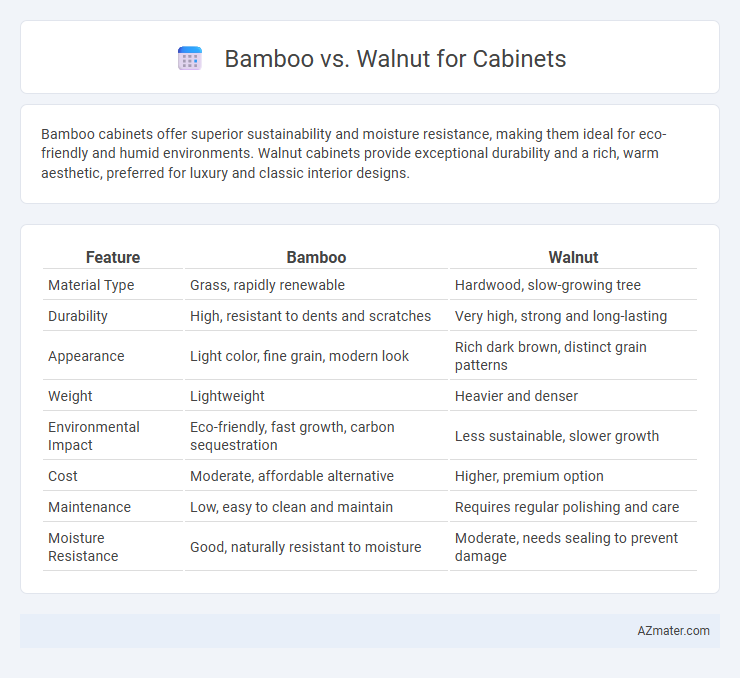Bamboo cabinets offer superior sustainability and moisture resistance, making them ideal for eco-friendly and humid environments. Walnut cabinets provide exceptional durability and a rich, warm aesthetic, preferred for luxury and classic interior designs.
Table of Comparison
| Feature | Bamboo | Walnut |
|---|---|---|
| Material Type | Grass, rapidly renewable | Hardwood, slow-growing tree |
| Durability | High, resistant to dents and scratches | Very high, strong and long-lasting |
| Appearance | Light color, fine grain, modern look | Rich dark brown, distinct grain patterns |
| Weight | Lightweight | Heavier and denser |
| Environmental Impact | Eco-friendly, fast growth, carbon sequestration | Less sustainable, slower growth |
| Cost | Moderate, affordable alternative | Higher, premium option |
| Maintenance | Low, easy to clean and maintain | Requires regular polishing and care |
| Moisture Resistance | Good, naturally resistant to moisture | Moderate, needs sealing to prevent damage |
Introduction: Comparing Bamboo and Walnut for Cabinets
Bamboo cabinets offer exceptional sustainability due to their rapid growth and renewable properties, making them an eco-friendly choice. Walnut cabinets stand out with rich, dark tones and distinctive grain patterns, providing a luxurious and timeless aesthetic. Both materials deliver durability and style, but bamboo excels in environmental benefits while walnut emphasizes elegance and classic appeal.
Sustainability and Environmental Impact
Bamboo cabinets offer superior sustainability due to bamboo's rapid growth rate and minimal pesticide requirements, making it an eco-friendly alternative to traditional hardwoods. Walnut, while durable and aesthetically pleasing, is harvested from slower-growing trees, resulting in a higher environmental impact and longer replenishment cycles. Choosing bamboo reduces deforestation and carbon footprint, positioning it as the greener choice for environmentally conscious cabinetry.
Appearance and Aesthetics
Bamboo cabinets feature a distinctive, uniform grain with a light, natural hue that brightens interiors and complements modern or eco-friendly designs. Walnut offers rich, deep brown tones with intricate grain patterns and natural variations, providing a luxurious and timeless appeal ideal for traditional or high-end cabinetry. The choice between bamboo and walnut hinges on desired aesthetics--bamboo suits minimalist, sustainable styles, while walnut elevates spaces with warmth and classic sophistication.
Durability and Strength
Bamboo cabinets offer exceptional durability due to their dense, fibrous structure, making them highly resistant to dents and scratches compared to traditional hardwoods. Walnut, a premium hardwood, provides superior strength with natural resistance to moisture and warping but is generally softer than bamboo and more susceptible to surface damage. Both materials are durable choices, but bamboo excels in hardness and environmental sustainability, while walnut offers robust longevity with a luxurious finish.
Cost and Affordability
Bamboo cabinets generally offer a more affordable option compared to walnut, with prices typically ranging from $40 to $60 per square foot, making them attractive for budget-conscious projects. Walnut, known for its rich color and durability, commands higher prices, often between $100 and $150 per square foot, reflecting its premium quality. Homeowners aiming for cost efficiency without sacrificing strength often prefer bamboo, while walnut suits those prioritizing luxury and long-term value despite the higher investment.
Maintenance and Care Requirements
Bamboo cabinets require regular cleaning with a damp cloth and mild detergent to prevent moisture damage, as they are prone to swelling in high humidity environments. Walnut cabinets demand periodic oiling or waxing to maintain their rich color and prevent drying or cracking, alongside gentle cleaning with non-abrasive products. Both materials benefit from avoiding excessive water exposure and direct sunlight to prolong their durability and aesthetic appeal.
Versatility in Design and Finishes
Bamboo offers exceptional versatility in design with its uniform grain and light color, easily adapting to modern and minimalist cabinet styles while supporting eco-friendly finishes. Walnut features rich, deep tones and distinctive grain patterns that bring warmth and elegance, ideal for traditional or luxurious cabinetry requiring diverse staining options. Both materials accommodate a range of finishes, but bamboo's adaptability to stains and laminates makes it a top choice for customizable, contemporary cabinet designs.
Suitability for Different Cabinet Styles
Bamboo cabinets offer a sleek, modern aesthetic ideal for contemporary and eco-friendly kitchen designs, characterized by their smooth texture and light color variations. Walnut cabinets, with their rich, deep tones and intricate grain patterns, complement traditional, rustic, and mid-century modern styles, adding warmth and sophistication. Both materials provide durability, but bamboo's sustainability appeals to green-conscious homeowners, while walnut's timeless elegance suits high-end, classic cabinets.
Resale Value and Market Trends
Walnut cabinetry commands a higher resale value due to its classic appeal and rich, dark grain that remains popular in luxury markets and high-end home renovations. Bamboo cabinets are gaining momentum as an eco-friendly and sustainable option, appealing to environmentally conscious buyers and modern minimalist designs, which positively impacts resale value in green housing markets. Market trends indicate increasing demand for bamboo in urban and contemporary homes, while walnut retains strong preference among traditional and upscale buyers, influencing pricing and resale potential accordingly.
Conclusion: Choosing the Best Wood for Your Cabinets
Bamboo cabinets offer superior sustainability, rapid renewability, and resistance to moisture, making them ideal for eco-conscious homeowners and humid environments. Walnut cabinets provide exceptional durability, rich color, and classic elegance, perfect for high-end, traditional kitchen designs. Selecting between bamboo and walnut depends on prioritizing environmental impact or timeless aesthetic, ensuring your choice aligns with both your practical needs and style preferences.

Infographic: Bamboo vs Walnut for Cabinet
 azmater.com
azmater.com